Here we present what is arguably the tastiest way to design and learn about electronic circuits: make circuitry snacks!
Two of our favorite things in the world are playing with electronics and playing with food, and so it is about time that someone finally got around to combining the two. We begin by gathering up appropriate snack-food building blocks and making food-based models of electronic components. From these components, you can assemble “circuitry snacks”– edible models of functioning electronic circuits. You can make these for fun, for dessert, for your geek friends, for kids, and for teaching and learning electronics.
Let’s begin by looking at some of the raw materials that are available and the sorts of things that we can make out of them. We’ll divide this up into several sections, for the substrates, wiring, and active and passive components. After that, we’ll put together a couple of simple circuits: a 555 LED Blinker and a Joule Thief.
Graham crackers (left) are a good starting point for building up a circuit– use them like circuit boards or perfboard. You can use icing to glue components down to the circuit board. You can also use frosting or icing to represent wires or traces on the circuit board. On the right is a set of blue Pop Tarts with sprinkles: could this be your next set of solar panels?
You can simulate the green “solder mask” layer on printed circuit boards by spraying your graham crackers with aerosol food coloring. It’s not particularly pleasant stuff, being spray paint and all. It leaves your boards slightly moist to the touch and the green powder that is deposited rubs off easily. None the less, it does look the part. Advanced technique (not shown): prior to applying the spray paint, mask off areas where your circuit board traces (printed wires) will be. You can use licorice strings (see below) or pretzel sticks to do the masking. After painting, remove the masks to expose the graham cracker colored lines below.
[Off-topic practical joke idea: lightly apply this green spray paint to hidden surfaces of (your housemate/roommate’s) bread or cheese. Instant mold!]
We’re also going to need a set of wires. Fortunately, this is an area where modern snack foods excel. There is quite a selection of wire-shaped extruded food, and we get our pick of it. First, these are “Fruit Streamers”, fruit snacks in the shape of a ribbon cable, with wires that can be pulled apart. Neat. While these purport to be polychromatic, the “blue” and “green” strands can hardly be told apart, and the opacity leaves something to be desired. None the less, here they are.

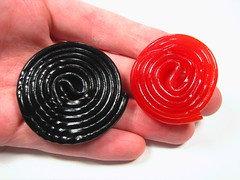
Haribo licorice wheels are a good source of red or black “wire.” The rolls are very long, and give you by far the longest wires that we had to work with. Downside: They tend to retain a serious curl even after dereeling.
Note: we aren’t sure why the red ones– presumably made in the same factory– are so much smaller. Maybe that’s how you’re supposed to tell the genders apart or something.
Air Heads Xtremes Sweetly Sour Belts. What… the… heck… is it? So far as I know, “belt” is not the name of any type of food. None the less, these exist and were in the candy aisle. I therefore infer that these are actually meant to be eaten.
While the colors are bright, and the components do separate, this was just awful to work with– the sticky surface texture left you feeling like you’d just been handling salted, fluorescent bacon. Yuck. They didn’t even get the colors of the rainbow in the right order. If you leave it intact, it might make a good looking ribbon cable, but it’s probably not worth the hassle.
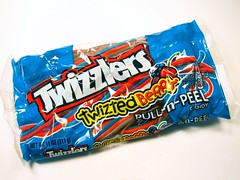
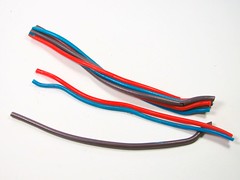
These Twizzlers “Twisted berry” wires, er, candy strands turned out to be the nicest to work with. Disgusting… yet great. Very bright, opaque, visible, strong, and can be neatly spliced. On the down side, it would be nice if they were longer.
They can be easily separated (right) into bright red and blue parts; there are also dull purple wires along for the ride.
Passive Components
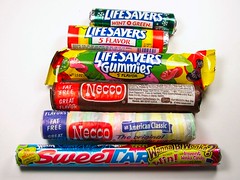
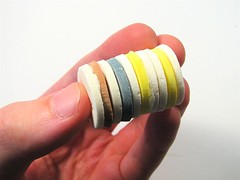
Here we have an assortment of roll candies: SweeTarts, Necco wafers, Lifesavers Gummies, Lifesavers 5-flavor, Lifesavers wint-o-green. These are (to various degrees) good raw materials for making cylindrical components like resistors or capacitors.
On the right is one of our failed experiments. It’s a stack of Necco wafers, where the colors are picked to make a resistor: Brown Black Yellow… Gold, or 100 k, 5%. The stack is held together with layers of icing. While this is an easy approach, it just doesn’t look that good. That’s because the color saturation of Necco wafers is poor and their inconsistent shape leads to large gaps between
neighboring wafers. (Perhaps a better use for the Necco wafers would be as ceramic disc capacitors.)
We made most of our resistors by creating stacks of four wint-o-green life savers, held together by icing. Once the icing has set (just a few minutes), you can use food coloring to paint the rings with the appropriate color code, brown-black-yellow-gold in this case. The great things about this technique are (1) it leaves a hole to put your wire through and (2) the white candy surface takes most colorations very well. There are certainly a lot of other ways to build resistors, and keep in mind that there is a lot of variation amongst even standard resistors.
On the right is a set of food coloring pens that we used to help color in the lines on the resistor. These are like the ones that we used to write on hearts, but with a broader tip.
This mixture of licorice candies simply boggles the mind. Not only are there the usual licorice “allsorts”, but gummy bears and even gummy frogs. It *looks like* it’s whatever fell off the side of the conveyor belt in the factory that makes the Haribo licorice candies. The most-unusual ones are interesting; A variety of odd shapes that look a lot like the odd shapes of capacitors that are available.
With the help of some pretzel sticks, you can take any one of those strange candy-coated licorice bits and turn it into an electrolytic capacitor with radial leads.
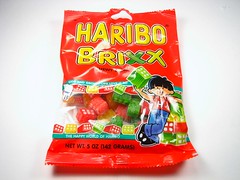
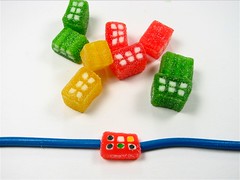
We recently found these Haribo “Brixx.”– which are thankfully not actually brick flavored. What’s interesting is that if you slice these thin, they make a great model of a certain type of capacitor.
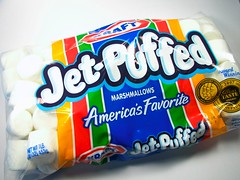
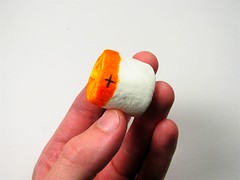
Regular old marshmallows. While these can be used for many different purposes in circuitry snacks, there are a few places where they really excel: As battery cells, as large electrolytic capacitors, and (when painted with a suitable set of colored stripes) resistors. On the right you can see one dressed up as a ‘C’ cell; an icing bump was added to one end of the marshmallow before painting that end orange.
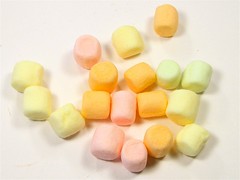
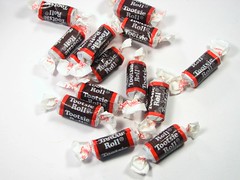
Two other building blocks that we have found to be generally handy: Miniature marshmallows and Tootsie rolls.
These miniature marshmallows come in a variety of pastel colors, but white will work just as well. They can be used in a variety of ways: as small electrolytic capacitors, as inductors, as glass-passivated components like diodes, and if painted suitably, as resistors in a circuit. Tootsie rolls are sculptable raw material, for which the possibilities are endless. For some earlier designs, we wrapped colored licorice bands around them to make resistors with color codes.
What is a jujube? We’ve always heard it pronounced “Joo-Joo-Bees,” but the spelling looks like it should read “Joo-Joobs.” Regardless, these hard little translucent cylinders are a bizarre suspension of sugar, starch and mineral oil– hence the “fat free” logo. They look a little bit like LEDs, or the lenses that go over them. If you wanted to build the edible equivalent of an LED matrix, these are your best bet. The translucent quality also lends them to play the role of glass-encapsulated diodes.
On the right are several 1N914 small-signal diodes that we’ve assembled from pretzel sticks, icing, food coloring, and either a jujube or a miniature marshmallow.
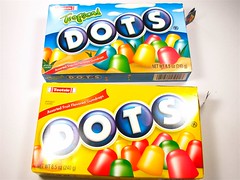

Dots are little gumdrops that look like regular sized (T-1 3/4) LEDs, if you stand them up on two toothpicks or pretzel sticks. (The prominent “LED” in the picture at the top of the photo is one of these.) Much like LEDs, regular Dots come in red, orange, yellow and green. If you want the elusive blue ones, you have to look hard. In this case, we found them in the box of “Tropical” Dots. There is also a second variety of black-colored Dots, called “Crows.” Crows are essentially identical in shape and size– and look like infrared LEDs or phototransistors.

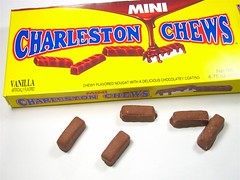
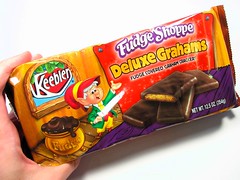
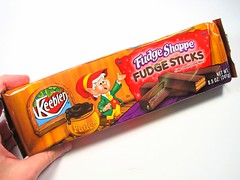
Any number of chocolate-bar-like foods can be made into edible versions of integrated circuits. Kit Kat, Twix, and Mini Charleston Chews are small components that make good models of integrated circuits in long, skinny packages. Chocolate covered graham crackers are another good option. The aspect ratio is good for doing large-scale models of (e.g.) 8-pin DIP packages; These are the ones that we made into 555s.
The “fudge sticks” are neatly rectangular layered wafer cookies with a thin chocolate coating. It’s kind of like a Kit-Kat bar in the limit where the cookie goes to unit volume where the chocolate coating goes to zero volume. Because they are so neatly rectangular, they make a good medium-size chip. Actually, they don’t taste half bad either.
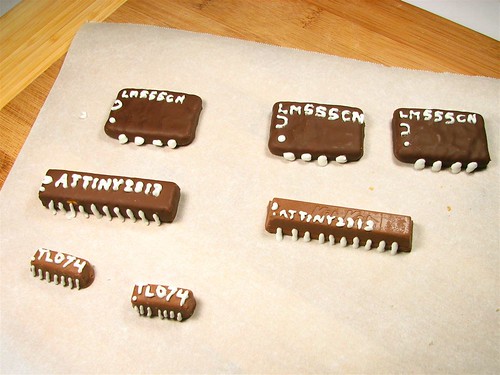
To make these chocolate-bar like items into chips, use hard icing to add a legend to the top, a marker by pin 1 and the correct number of pins to the edges. Be sure to do this on waxed paper or parchment paper so that you can unstick the legs after they harden.
The smaller chips here are charleston chew based quad op-amps (TL074). The two ATtiny2313s shown here are based on a “fudge stick” and a Kit Kat.
The three 555 chips (at a different scale) are made from chocolate-covered graham crackers with icing detail.

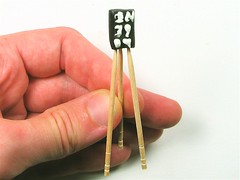
Twizzlers nibs: short black pieces of licorice with a D-shaped profile. Perfect for making those little TO-92 shaped food projects, e.g., a 2N3904 transistor. Here, we’ve written the designation on the surface– it’s very tricky to squeeze out icing that fine.
We’ve also added three toothpick feet. Toothpicks are not, strictly speaking, food. However, they are often *allowed* as structural component to assemble food.
An even better trick is to avoid the use of toothpicks at all, by making edible legs for your components. You can do this by making rigid icing rods. Lay down even stripes of icing on parchment paper and allow to dry overnight. Pick them off the parchment and use icing to attach them where they need to go. In this case, we’ve made a transistor by sticking several of the solidified icing sticks to the bottom of the licorice piece. This way it’s fully edible– much better than using toothpicks!
Putting it all together
Let’s start putting some boards together. On the left is a simple board featuring a full-size Kit Kat, made into an AVR ATmega168. We have supplied this board with power connections via the ribbon cable.
In the board on the right we have an ATtiny2313, a TL074 quad op-amp and a 1N914 diode. For both of these boards, we are modeling the circuit as a printed circuit board where the components are visible but the traces on the printed circuit board are not; it’s certainly sufficient detail for most folks to recognize this as a circuit board.
The next step is to make the logical leap to designing a detailed circuit out of edible components:

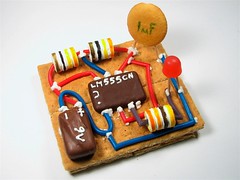
What’s better than a 555 LED blinking circuit? A 555 LED blinking circuit that you can eat!
To make this, we started with the graham cracker circuit board, two 100k (brown-black-yellow) resistors and one 330 ohm (orange-orange-black) all made from lifesavers. The 555 is a chocolate covered graham cracker, the 1 uF ceramic disc capacitor was formerly a Nilla wafer. The 9V battery was made from a “fun size” Three Musketeers bar. The red LED came out of a box of Dots, and all the wiring is Twizzlers “berry” wire, all soldered together with hard icing.
This circuit is the starting point for a lot of good things, for example the Cylon Pumpkin.
The next circuit that we’re building here is a Joule Thief, a simple boosting power supply that can run a blue LED from a single 1.5 V battery. That’s a neat trick, since it usually takes at least 3.5 V to run a blue LED.
This circuitry snack contains a marshmallow battery, a 1 k (brown-black-red) resistor, a bifilar wound toroidal coil (wound around a Sushki— like a hard miniature bagel cookie), a 2N3904 transistor, and a blue LED.
So, we’ve walked through some of the snack food choices that seem promising for circuitry snacks, how to assemble them into simulated electronic components, and how to put them all together on an edible circuit board.
What other cool ideas for candy circuits can you come up with? We’re looking forward to seeing the results!




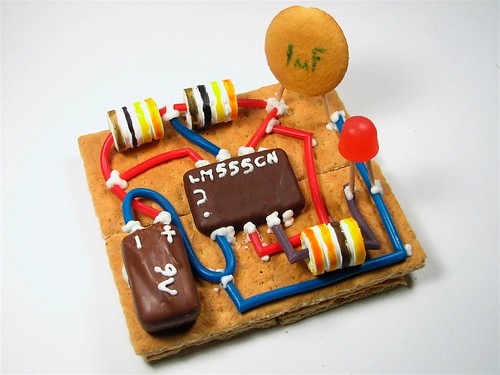

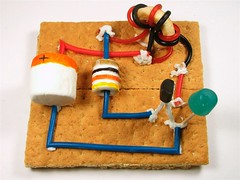
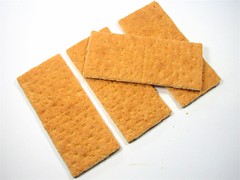


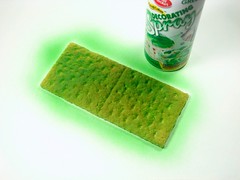
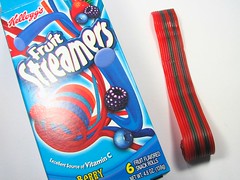
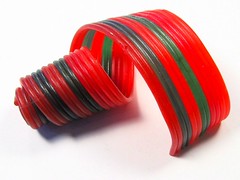
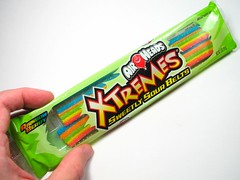
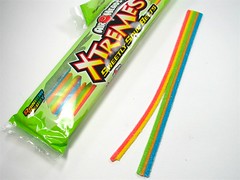


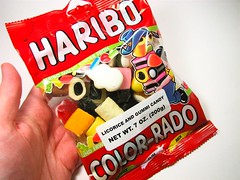
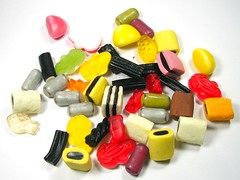
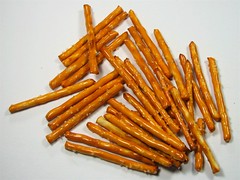
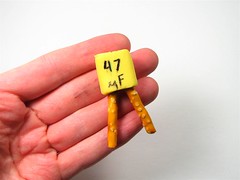
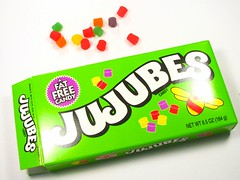
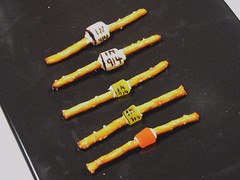
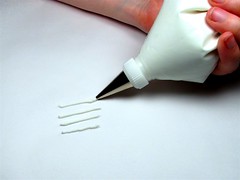
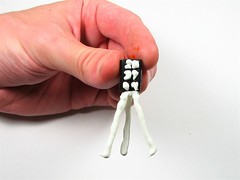
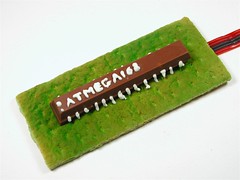

Wow…
Guys, that is the best use for candy, EVER!
:D
Thanks!
—
Windell H. Oskay
drwho(at)evilmadscientist.com
http://www.evilmadscientist.com/
Where is evil?
Where is Madness?
This is just perfect.
We must pick up our tradition of make ginger bread machinery for X-mas. I am inspierd.
Good job; it looks delicious! What do you think you could use for a crystal oscillator, though?
I would probably use a piece of white rectangular candy– maybe a piece of a white chocolate bar or toffee. If you really want to get the best looking crystal oscillator, consider using edible silver leaf.
—
Windell H. Oskay
drwho(at)evilmadscientist.com
http://www.evilmadscientist.com/
Another possibility would be shortbread. Trader Joe’s Ginger Shortbread Squares are yummy little things.
Those are really cool.
Kevin
LANL
That’s a real great job you did with all the experimenting and testing different types of candy.
I did a similar thing once on a friend’s birthday party, but on a much smaller scale, using mainly black liquorice wheels (for wires), Maoam (don’t know if you have them in the USA, they’re white, relatively hard rectangular blocks) as well as brightly colored gummy parts (probably out of Haribo Colorado bags) for components. No circuit boards though, and no icing either, components that won’t stick by themselves often do if you lick them ;-). It took me almost twice as long than the others to finish my "meal" afterwards even with this "minimalistic" approach :-).
— Arne
i love the care and detail, e.g. cutting the wires at an angle, so they will fit around corners. careful descriptions, discussions on what went less well…
very nice!
this also gave me the idea of baking a giant molecule, which would fit with my area of work. just need to think of a good approach first…
This is quite possibly the best thing I have ever seen on the internet. ^_^
Looks like I’ll be changing my grocery list around quite a bit…
Love this post!
I think I know why Haribo red licorice wheels are smaller: Haribo is a french company, and in france we don’t have red licorice at all, so perhaps it’s not made at the same factory…
According to Haribo, they have eighteen factories, all in Europe. They don’t specify which candies are made at which factories, so you could be right.
i think it’s german.
Very very cool..
Actual jujubes are a small, odd, slightly sweet Asian fruit with a texture that is somehow both spongy and slightly crisp. Having tasted them, I’m not sure why the candies were named after them (since the fruits are not brightly colored, gummy, translucent, or at all similar to the flavors of the candy), but that’s where it comes from. There are recipes for candied jujube fruits, so perhaps in that form the resemblance would be closer.
At any rate, delightful work!
-esoterika
Absolutely great, building, testing and eating -> and the best argument to buy HARIBO-stuff for just scientific purposes…;))
My geeklings are going to love this. Kudos for using so many candies that (just happen) to be safe for peanut allergies.
It looks like you have some cold solder joints there. tsk tsk. =)
check http://www.danos.nl, he made working ones ;)
You guys just frickin’ RAWK. That is all.
Gawd, I love it when food meets tech!
Very amusing victuals.
WOW!
There IS NO limit to human creativity !!
Congratulations. I will be off focus for the rest of the day–
why not try spagetti at different appropriate al-dente-levels as component leads while they are "strictly speaking, food" :)
(yes, can be eaten un-cooked – a balance between allocatable time and hunger)
I know it’s been a while since your post, but HaRiBo stands for "Hans Riegel Bonn" in which Hans Riegel stands for the name of the guy who founded this company and Bonn is the name of the town where the first factory opened. Bonn in germany. I don’t even know, whether there’s a Bonn in France :D
Maybe the red ones are just smaller because they don’t taste as good as the black ones ^^